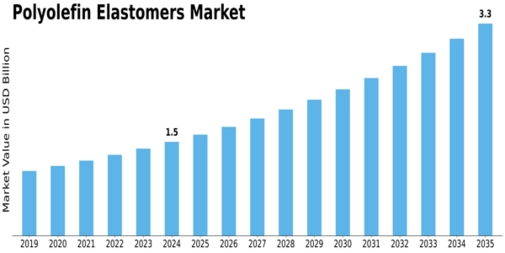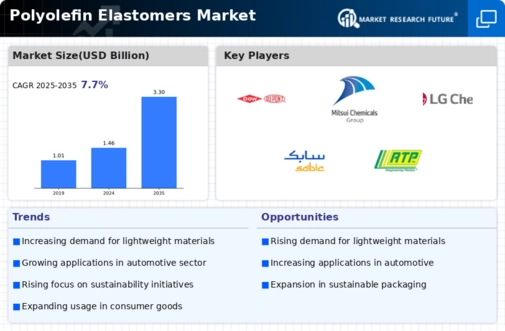Market Growth Projections
The Global Polyolefin Elastomers Market Industry is poised for substantial growth, with projections indicating a market value of 1.46 USD Billion in 2024, expected to reach 3.3 USD Billion by 2035. This growth trajectory suggests a compound annual growth rate (CAGR) of 7.69% from 2025 to 2035, reflecting the increasing adoption of polyolefin elastomers across various sectors. The expanding applications, coupled with technological advancements and sustainability trends, are likely to drive this growth, positioning the market favorably for future developments.
Rising Demand from Automotive Sector
The automotive industry is a crucial driver for the Global Polyolefin Elastomers Market Industry, as manufacturers increasingly seek lightweight materials to enhance fuel efficiency and reduce emissions. Polyolefin elastomers, known for their flexibility and durability, are being utilized in various automotive applications, including interior components and exterior trims. As the automotive sector continues to evolve, the demand for polyolefin elastomers is projected to rise significantly, contributing to the market's growth. In 2024, the market is valued at 1.46 USD Billion, with expectations to reach 3.3 USD Billion by 2035, indicating a robust CAGR of 7.69% from 2025 to 2035.
Growth in Consumer Goods Applications
The Global Polyolefin Elastomers Market Industry is experiencing substantial growth due to the increasing utilization of these materials in consumer goods. Products such as flexible packaging, household items, and personal care products benefit from the unique properties of polyolefin elastomers, including their softness and resilience. As consumer preferences shift towards high-performance materials that offer both functionality and aesthetic appeal, manufacturers are increasingly incorporating polyolefin elastomers into their product lines. This trend is expected to drive market expansion, as the demand for innovative and sustainable consumer goods continues to rise.
Technological Advancements in Production
Technological advancements in the production of polyolefin elastomers are significantly influencing the Global Polyolefin Elastomers Market Industry. Innovations in polymerization techniques and processing methods have enhanced the efficiency and quality of elastomer production. These advancements enable manufacturers to produce materials with tailored properties, catering to specific applications across various industries. As production processes become more efficient, the cost of polyolefin elastomers may decrease, further driving their adoption in diverse applications. This trend suggests a positive outlook for the market, as companies leverage technology to meet growing demand.
Expanding Applications in Medical Devices
The Global Polyolefin Elastomers Market Industry is witnessing growth due to the expanding applications of these materials in the medical sector. Polyolefin elastomers are increasingly used in medical devices, such as tubing, seals, and gaskets, owing to their biocompatibility and flexibility. As the healthcare industry continues to innovate and develop new medical technologies, the demand for high-performance materials like polyolefin elastomers is expected to rise. This trend indicates a promising future for the market, as healthcare providers seek reliable and safe materials for medical applications.
Sustainability Trends in Material Selection
Sustainability trends are increasingly shaping the Global Polyolefin Elastomers Market Industry, as consumers and manufacturers alike prioritize eco-friendly materials. Polyolefin elastomers, being recyclable and less harmful to the environment compared to traditional materials, are gaining traction in various applications. Companies are actively seeking sustainable alternatives to meet regulatory requirements and consumer expectations for environmentally responsible products. This shift towards sustainability is likely to bolster the market, as more industries adopt polyolefin elastomers to align with green initiatives and reduce their carbon footprint.









Leave a Comment